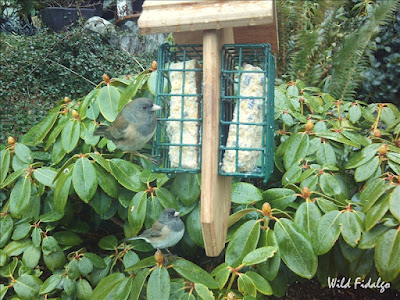Dark-eyed Junco
 |
| Male and Female Dark-eyed Junco (Junco hyemalis) |
Like the swallows to Capistrano and buzzards to Hinckley, the Juncos return to South Fidalgo every fall. This event adds another chime to our seasonal clock. The Dark-eyed Junco (Junco hyemalis) has always been one of my favorite birds. They are not flashy or brightly colored. Nevertheless, their tasteful, muted tones gives us one of our most attractive little birds. Ours are the "Oregon" variant with a black hood for males and gray hood for females. Take a pair of these charming birds, add a snowy holly branch, and you have a perfect Christmas card image.
In other parts of North America, your Dark-eyed Juncos may look completely different. Depending on region, they also come in "Slate-colored," "Pink-sided," "White-winged," "Red-backed" and "Gray-headed" variants. At the moment, they are all considered the same species, an indication they possess a high genetic diversity. Even among the local birds, there is variation in markings and color tones, especially in the browns and grays. If you consider the wolf genome and domestic dogs, it is apparent such diversity is not unusual in the animal world.
During the winter, Juncos are the most abundant birds I see on South Fidalgo. In the wild, they are ground feeders, and they like to scratch around in the garden. They readily adapt to elevated feeders, but I also spread some seed on the patio for them every day. As you can see in the photos, they are not picky eaters. I might see groups of twenty or thirty at a time around the yard. According to iBird, a group of Juncos is called an "ubiquity" or a "crew." They are always agreeable among themselves and towards other birds.
I have noticed a couple of interesting behaviors at the BirdCam stations. More than other birds, they appear to engage the camera like vain movie stars. They act as if aware they are being photographed. Then, I often catch a "watcher" at the rhododendron station, and it is always a male. He perches in the background as if keeping an eye on things. This would be similar to male behavior in their nesting grounds.
By the end of March, the Juncos will have all departed my South Fidalgo neighborhood. I won't see any until the next fall. They are forest ground nesters, and probably seek suitable habitats free of raccoons and other predators. Based on their numbers, the strategy seems to be working.




